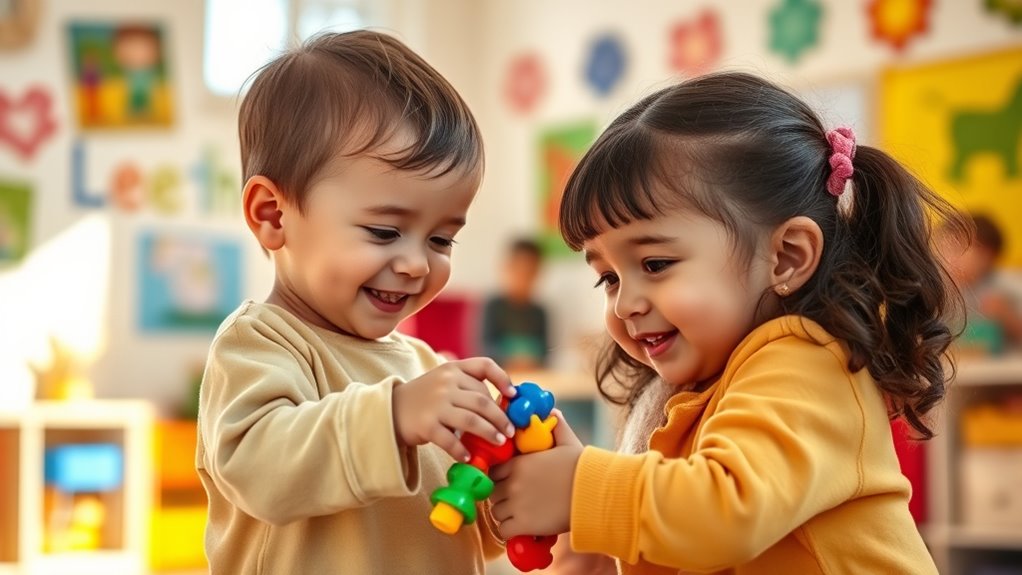To encourage empathy and kindness in early childhood, focus on modeling compassionate behavior, openly sharing your feelings, and creating safe spaces for emotional conversations. Use everyday actions, words, and stories to help children understand and share emotions. Playdate and group activities are great opportunities to practice kindness and active listening. Consistency and positive reinforcement are key. Keep exploring ways to nurture these important skills as your child grows, and you’ll see their empathy and kindness flourish.
Key Takeaways
- Model empathy and kindness through everyday actions and open emotional sharing to teach children by example.
- Use age-appropriate language and questions to help children recognize and express their feelings effectively.
- Create safe spaces for honest emotional conversations, validating and respecting children’s emotions.
- Encourage social interactions like playdates to practice sharing, active listening, and showing kindness.
- Reinforce positive behaviors through praise, consistent modeling, and narrating acts of compassion and understanding.

Fostering empathy and kindness in early childhood sets the foundation for healthy social skills and positive relationships throughout life. As a caregiver or parent, your role in guiding children to understand and share emotions is crucial. When you openly express your feelings and demonstrate compassion, you teach children how to recognize and respond to others’ emotions. For instance, if you see someone upset, you might say, “I see you’re feeling sad. It’s okay to feel that way,” showing children that emotions are natural and manageable. This modeling behavior helps children learn to identify their own feelings and empathize with others. Sharing your emotional experiences in an age-appropriate way allows children to see that everyone experiences a range of feelings, fostering connection and understanding.
Encouraging children to share their emotions creates a safe space for honest conversations. When they feel comfortable expressing what they’re feeling, they develop emotional awareness, which is essential for empathy. You can prompt this by asking questions like, “How did that make you feel?” or “What are you feeling right now?” Be attentive and responsive, showing that their emotions matter. This acknowledgment not only validates their feelings but also teaches them to respect others’ emotions. When children see you listening and responding kindly to their sharing, they learn to do the same for their peers, cultivating empathy and kindness.
Model behavior consistently. Children learn a lot through imitation, so your actions matter. Show kindness in everyday interactions—whether it’s sharing a toy, offering a comforting hug, or speaking gently during disagreements. When they see you resolving conflicts calmly and respectfully, they understand that kindness and empathy aren’t just words but behaviors to emulate. It’s also effective to narrate your actions: “I’m helping my friend because I know they’re feeling sad,” which reinforces positive behavior. Over time, children internalize these lessons and begin practicing empathy and kindness themselves.
Creating opportunities for children to practice sharing emotions and modeling positive behavior helps reinforce these skills. Playdates, group activities, and family discussions are perfect for this. Encourage children to express their feelings and listen actively to others’ stories. Praise their efforts when they show kindness or empathy, reinforcing that these qualities are valued. Remember, consistency is key—by continuously demonstrating and encouraging sharing emotions and modeling behavior, you help children develop into empathetic, considerate individuals who can build meaningful relationships throughout their lives.
Frequently Asked Questions
How Early Can Children Start to Show Empathy?
Children can start to show empathy as early as age two, reaching key empathy milestones around ages three to four. At this stage, their emotional awareness grows, and they begin to recognize others’ feelings. You’ll notice them comforting a friend or sharing toys, demonstrating an emerging understanding of empathy. By nurturing their emotional awareness, you help them develop stronger social skills and a genuine sense of kindness early on.
What Are Common Challenges in Teaching Kindness?
You might face unexpected hurdles when teaching kindness, especially in bullying prevention and social skills. Kids can be resistant or misinterpret cues, making it tricky to foster genuine empathy. Sometimes, they imitate negative behaviors or struggle to see others’ perspectives. Managing these challenges requires patience, consistency, and creative strategies to help children develop kindness naturally, ensuring they learn how to support and understand their peers effectively.
How Can Parents Model Empathetic Behavior Effectively?
You can effectively model empathetic behavior by demonstrating role modeling and emotional awareness daily. Show your child how to listen attentively, express understanding, and handle emotions calmly. When you acknowledge your feelings openly and respond kindly to others, you teach them the importance of empathy. Your consistent actions, like sharing and showing compassion, set a strong example that encourages your child to develop these essential social skills naturally.
Are There Specific Activities That Promote Empathy Development?
Getting to the heart of the matter, yes, specific activities like role-playing games and story-sharing activities can do wonders for empathy development. These activities allow your child to walk in someone else’s shoes and see the world from different perspectives. You’re killing two birds with one stone by making learning fun and meaningful, fostering empathy naturally as they navigate different scenarios and emotions.
How Do Cultural Differences Influence Kindness in Children?
Cultural differences shape how children understand and express kindness through varying norms and social expectations. You might see children from different backgrounds practicing kindness uniquely, influenced by their community’s values. By observing these differences, you can learn to foster empathy in ways that respect each child’s cultural context. Encouraging open conversations about diverse kindness practices helps children appreciate and adapt to different social expectations, strengthening their empathetic skills.
Conclusion
By nurturing empathy and kindness early on, you plant seeds that grow into a caring heart, like a gentle gardener tending delicate flowers. Remember, your words and actions shape your child’s ability to understand and share others’ feelings. When you model compassion daily, you create a ripple effect that spreads kindness far beyond today. Together, you can build a world where empathy blossoms naturally, making every interaction a chance to connect and uplift others.








